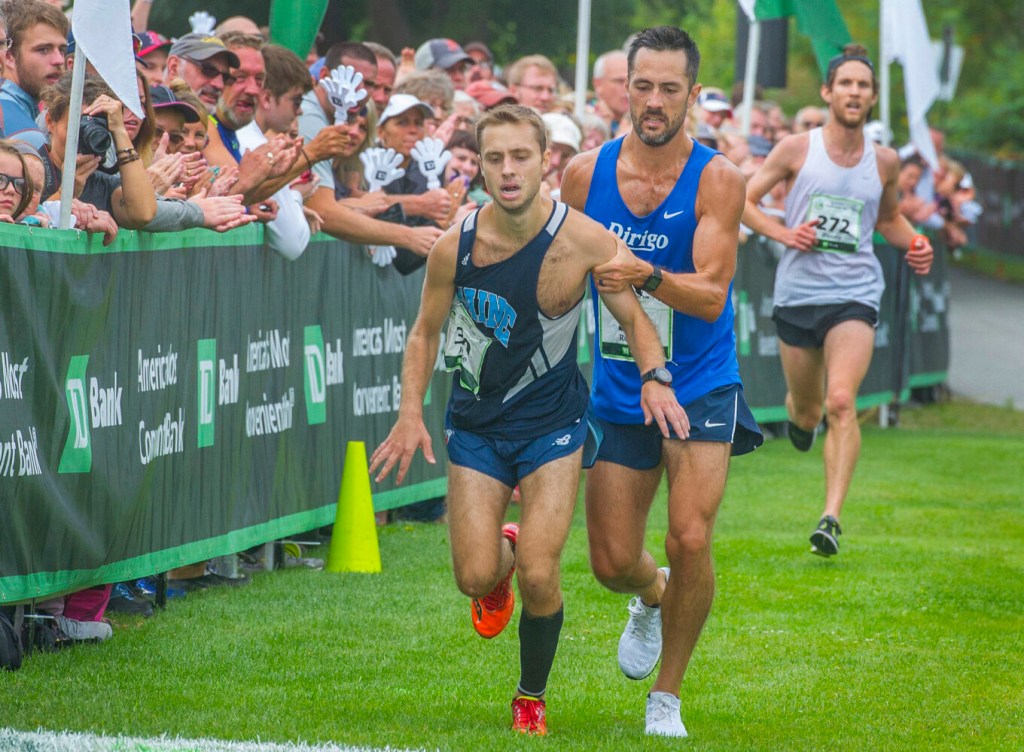Most of us are familiar with “bystander apathy”: the chilling idea that large groups of people can watch horrific crimes without feeling compelled to step in and help.
The idea first gained traction after the 1964 killing of Kitty Genovese, a 28-year-old New Yorker who, it was believed at the time, was killed as 38 people looked on. While the number of eye witnesses was later found to be untrue, the story has become a cautionary tale to explain high-profile tragedies and the decaying of society.
But new research suggests we should take a rosier view of human nature.

Helping a stranger. At the finish of the 2107 Beach to Beacon race, Robert Gomez helped Jesse Orach to the finish line after Orach had collapsed just before the line. Gomez’ extraordinary act of sportsmanship gave Orach the extra help he needed to cross the line and win his division. Staff photo by John Ewing
Bystanders will intervene 9 times out of 10 to assist the victim in a public fight, an international team of researchers found in a study called “Would I be helped?,” published in American Psychologist this summer. After reviewing surveillance footage of more than 200 violent altercations around the world, the researchers concluded that having more bystanders around makes it more likely that someone will intervene.
“Our study suggests that if assaulted in public you will most likely be helped by a bystander,” said Richard Philpot, a psychology research fellow at Lancaster University and the study’s lead author. “This is reassuring for potential victims of violence, the public as a whole, and . . . has important implications for our understanding of bystanders as a crime-preventive resource.”
Philpot and his team examined 219 CCTV videos of assaults or arguments in three major cities: Amsterdam; Cape Town, South Africa; and Lancaster in the United Kingdom.
The researchers selected their videos based on a few criteria: The filmed encounter had to be “aggressive,” involving behavior ranging from “animated disagreements to grave physical violence,” according to the study. It had to involve at least two main participants, and it had to develop organically – the team discounted videos of traffic accidents, robberies and drug deals. Finally, it had to begin without police or paramedics present.
Philpot’s team watched every altercation until it dissipated naturally or until police arrived to break it up. The team then recorded whether bystanders – whom they defined as anyone not involved in the original argument – did anything to “placate the conflict,” according to the study.
The researchers counted any of the following activities as placation, per the report: “pacifying gesturing,” “calming touches,” “blocking contact” between the people arguing, “holding, pushing or pulling an aggressor away,” “consoling a victim” or “providing practical help” to anyone who suffered physical injuries.
After watching all the videos and crunching all the numbers, Philpot and his team found that at least one bystander decided to help out in 91 percent of the cases studied. On average, at least three people chose to intervene – and every additional bystander present increased the odds that the victim would receive assistance by roughly 10 percent.
“The high level of help was surprising,” Philpot said. He said the findings “overturn the impression of the ‘walk on by society’ in which victims are largely ignored by bystanders.”
The researchers also found that there was no statistically significant difference in the rates of bystander intervention across the three cities studied. Philpot said this suggests that “people have a natural propensity to help others in distress,” no matter their nationality.
Philpot was inspired to conduct the study after noticing that many of his peers in the social sciences, as well as members of the media, took for granted the idea that bystanders are generally indifferent to the plight of others. He also noticed that most previous research into bystander intervention relied on laboratory experiments or self-reported accounts of violent incidents, both of which can be “unreliable” and sometimes “strip out complexity,” he said.
In contrast to past work, Philpot wanted to scrutinize “actual bystander behavior in real-life public emergencies” – something only possible to assess via security-camera footage. His research represents the largest study of real-life arguments captured on CCTV, he said.
While his findings challenge the notion of bystander apathy, Philpot emphasized, he and his team did not test the equally well-known “bystander effect”: a psychological claim that the greater the number of bystanders at the scene of a crime, the less likely each individual is to help (perhaps because they assume someone else will do so).
That may still hold true, Philpot said. His team did not explore individual bystanders’ motivations. Instead, the researchers focused on the “situational likelihood of intervention,” Philpot said, whether at least one person in a large group will step in to intervene in a conflict.
All of the cases Philpot and his team studied played out in urban, inner-city environments. He said future work should explore whether bystander intervention rates vary in different contexts – for example, in rural areas.
In the meantime, though, he hopes his study will accomplish a “reframing” of the way society thinks about bystanders.
“[It] offers an alternative narrative to . . . ‘stranger danger,’ ” he said. “Bystanders should be recognized as ‘first responders’ who can provide informal help before the arrival of the police.”
Comments are not available on this story.
Send questions/comments to the editors.


